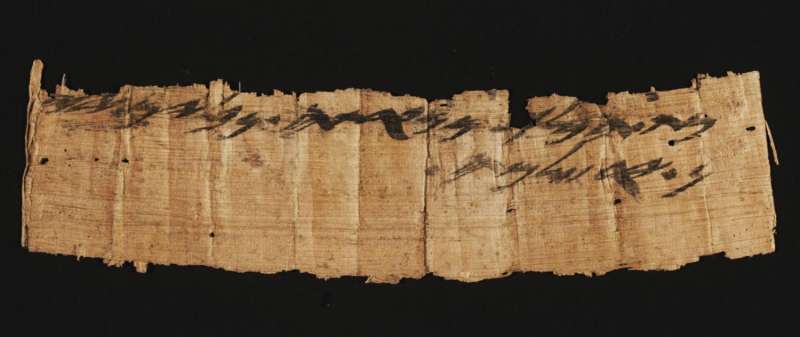Credit: Shai Halevi, Israel Antiquities Authority
(Phys.org)—Eitan Klein, a representative of the Israel Antiquities Authority, has announced that an important papyrus document dated to 2,700 years ago has been seized from a group of Palestinian looters who reportedly dug it up in a cave in the Judean Desert approximately three years ago. The claim of its authenticity has been challenged, however, by Christopher Rollston (as reported by Live Science) a professor with George Washington University in the U.S.—he contends that the wording on the document suggests it might be a forgery.
If the document turns out to be authentic, it will be notable for a line that translates from Hebrew as "from the king's maidservant, from Na'arat, (which was near Jericho)—jars of wine, to Jerusalem." This sentence would mark the second-oldest reference to Jerusalem—the Bible is the oldest. It would also be important because it suggests the lines were written by a woman from the time of the First Temple (which King Solomon had built in 957BC—but it was destroyed by soldiers working for King Nebuchadnezzar, the Babylonian king, approximately 400 years later), who held an important position in society.
Klein outlined the means by which he and his team tracked the looters and eventually caught them in the act of looting a cave. He did not give specifics as to how the scroll was found, but hinted that it might have been purchased after being tracked to an antiquities market somewhere in Jerusalem. The scroll has already been carbon dated, but as Rollston noted, if it were a fake, the forger would have simply obtained a blank scroll from that time period and written on it using the same type of ink used thousands of years ago. In response, Klein has offered to listen to evidence by Rollston, but suggests that he and his team are very nearly certain the papyrus is an authentic document because they have proof that it was dug up by looters from a cave in the Nahal Hever valley—they are not revealing its exact location for fear that other looters will descend on the scene. The papyrus and the lines written on it will no doubt be studied in more detail by other researchers who may or may not come to a consensus on the authenticity of the scroll.
© 2016 Phys.org
























